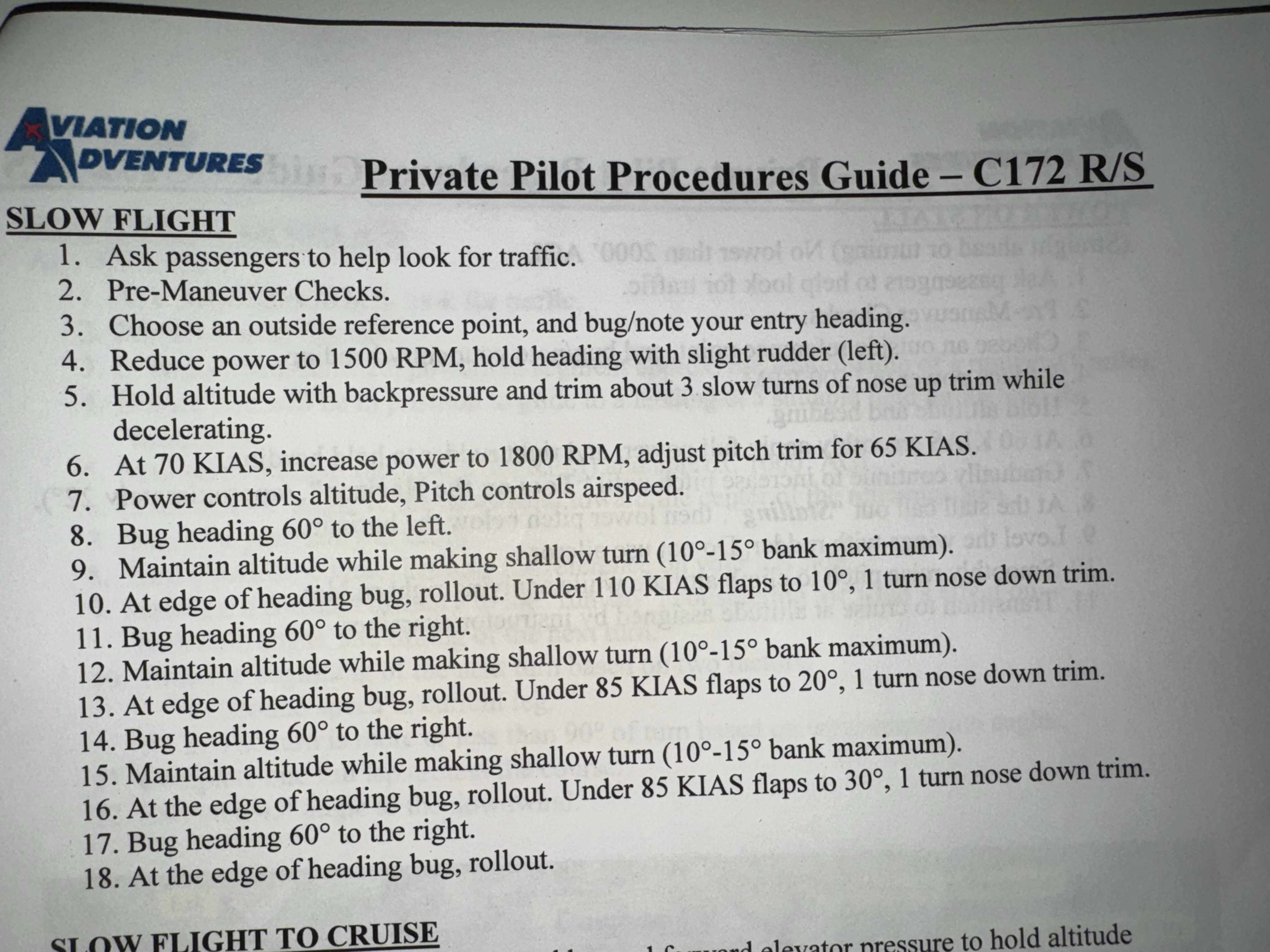Slow Flight Procedures for Cessna 172 Pilots
Private Pilot Procedures Guide – C172 R/S

Slow Flight Procedures
-
Ask passengers to help look for traffic.
- Thoughts: It's essential to maintain situational awareness during slow flight operations. Engaging passengers in this way can help ensure safety by having more eyes on potential traffic.
- Additional Info: This practice is especially important in busy airspaces.
-
Pre-Maneuver Checks.
- Thoughts: Conducting checks prior to maneuvers is crucial to confirm that the aircraft is in a safe condition to operate.
- Additional Info: This could include checking fuel levels, systems, and confirming that all passengers are secured.
-
Choose an outside reference point, and bug/note your entry heading.
- Thoughts: Selecting a stable reference helps in maintaining control and orientation during slow flight.
- Additional Info: “Bugging” refers to setting a heading on the aircraft's directional indicator for navigation.
-
Reduce power to 1500 RPM, hold heading with slight rudder (left).
- Thoughts: Reducing power allows the aircraft to slow down without losing altitude rapidly.
- Additional Info: Using slight rudder input helps maintain coordinated flight.
-
Hold altitude with backpressure and trim about 3 slow turns of nose up trim while decelerating.
- Thoughts: Balancing pitch during deceleration is key to maintaining altitude.
- Additional Info: Trim adjustments help alleviate control pressure on the yoke.
-
At 70 KIAS, increase power to 1800 RPM, adjust pitch trim for 65 KIAS.
- Thoughts: This step transitions the aircraft from standard slow flight to a controlled slower flight speed.
- Additional Info: KIAS stands for Knots Indicated Airspeed, a critical measurement for maintaining safe flight.
-
Power controls altitude, Pitch controls airspeed.
- Thoughts: Understanding this principle is fundamental in flight.
- Additional Info: Power (throttle) adjustments primarily impact altitude, while pitch angle affects the airspeed.
-
Bug heading 60° to the left.
- Thoughts: Following a planned route is crucial for effective navigation.
- Additional Info: Consistency in heading helps avoid unnecessary altitude changes.
-
Maintain altitude while making shallow turn (10°-15° bank maximum).
- Thoughts: Shallow turns are safer in slow flight to prevent stall situations.
- Additional Info: Maintaining bank limits reduces the risk of excessive lift loss.
-
At edge of heading bug, rollout. Under 110 KIAS flaps to 10°, 1 turn nose down trim.
- Thoughts: Rollout indicates transitioning back to straight flight for altitude maintenance.
- Additional Info: Flap adjustments help regain lift when needed, particularly in slow flight.
-
Bug heading 60° to the right.
- Thoughts: Similar to number 4, maintaining a specific heading is essential for effective navigation.
- Additional Info: Constant adjustments may be necessary to stay on the correct course.
-
Maintain altitude while making shallow turn (10°-15° bank maximum).
- Thoughts: Repetition reinforces muscle memory in managing slow flight maneuvers.
- Additional Info: Consistency in technique is vital in developing good flying habits.
-
At edge of heading bug, rollout. Under 85 KIAS flaps to 20°, 1 turn nose down trim.
- Thoughts: This step further prepares the aircraft for landing configurations by adjusting flaps.
- Additional Info: Adjustments are crucial as airspeed decreases.
-
Bug heading 60° to the right.
- Thoughts: Attention to navigation aids in maintaining a safe flight path.
- Additional Info: Consistency in following headings is vital to prevent disorientation.
-
Maintain altitude while making shallow turn (10°-15° bank maximum).
- Thoughts: Regular practice in shallow turning helps build confidence in handling the aircraft.
- Additional Info: Effective control inputs are necessary to maintain good flight posture.
-
At the edge of heading bug, rollout. Under 85 KIAS flaps to 30°, 1 turn nose down trim.
- Thoughts: Preparing for landing with the appropriate flap settings increases control as speed decreases.
- Additional Info: Understanding flap deployment enhances overall safety during approach.
-
Bug heading 60° to the right.
- Thoughts: Indicates a systematic approach to maintaining a focus on navigation.
- Additional Info: Revisiting the bugged headings ensures adherence to flight paths.
-
At the edge of heading bug, rollout.
- Thoughts: Finalizing the procedure ensures readiness to transition to the next phase of flight.
- Additional Info: Effective communication and control inputs aid in smooth operations.
Summary
The notes detail a comprehensive approach to performing slow flight maneuvers in a Cessna 172, emphasizing safety, control, and navigation throughout the process. Understanding and following these procedures is crucial for developing proficiency as a pilot.
Extended readings: